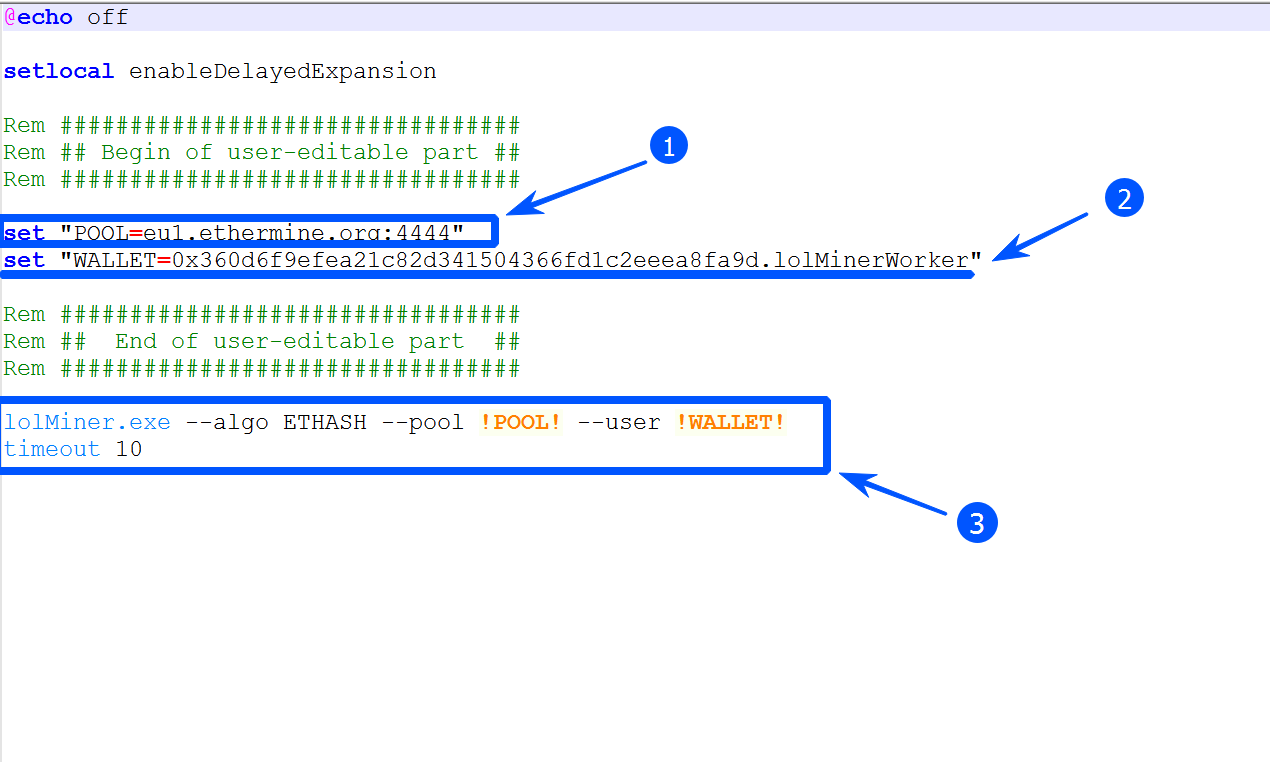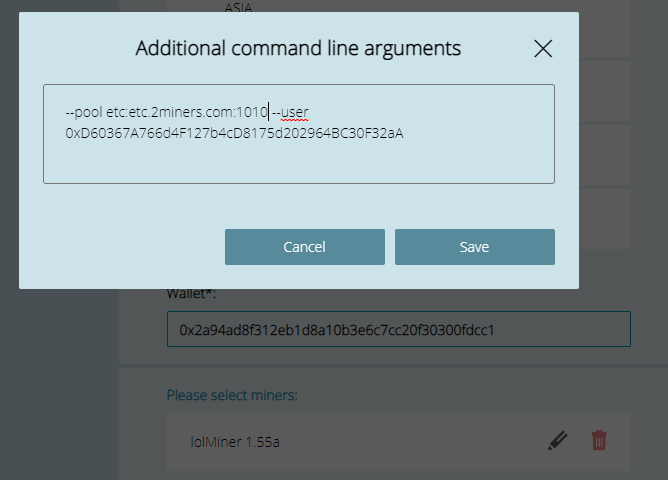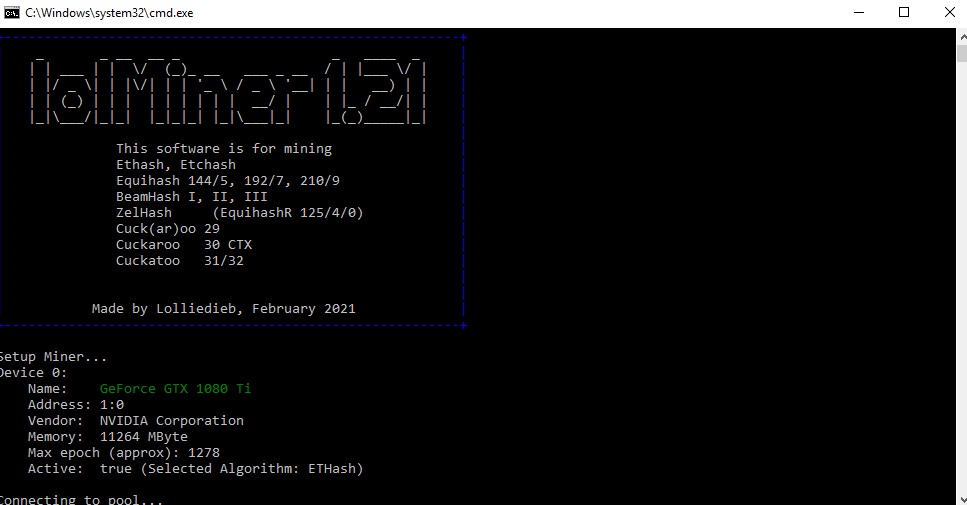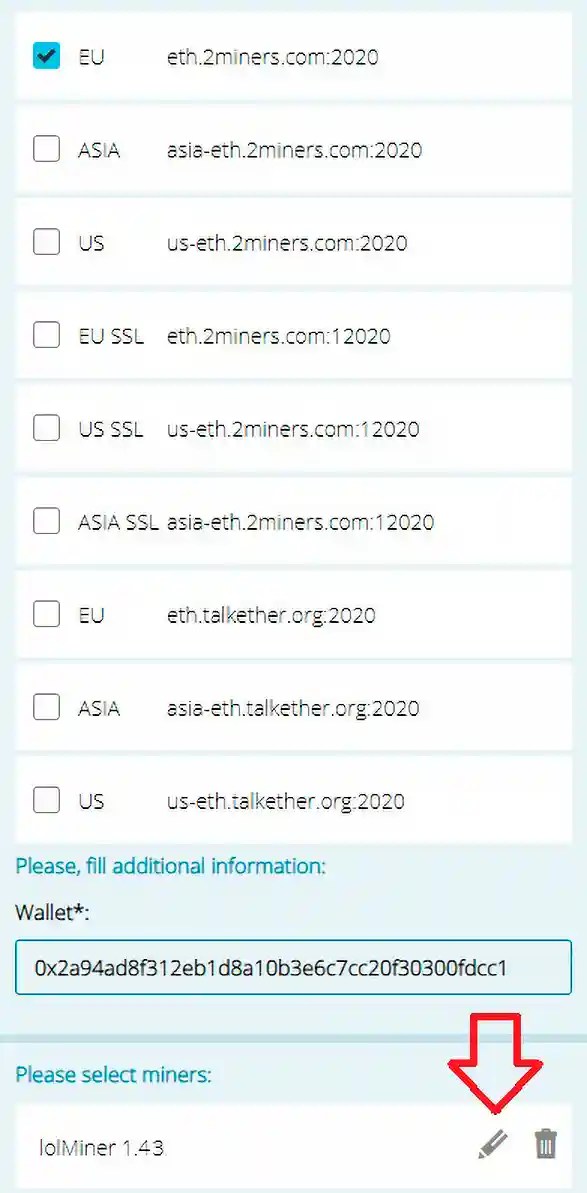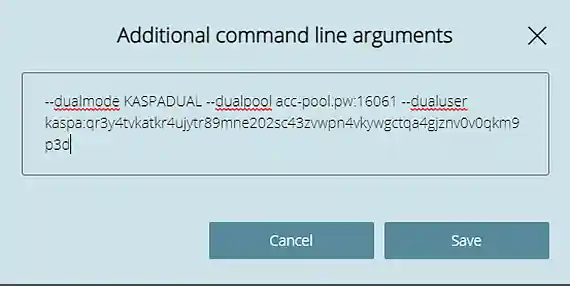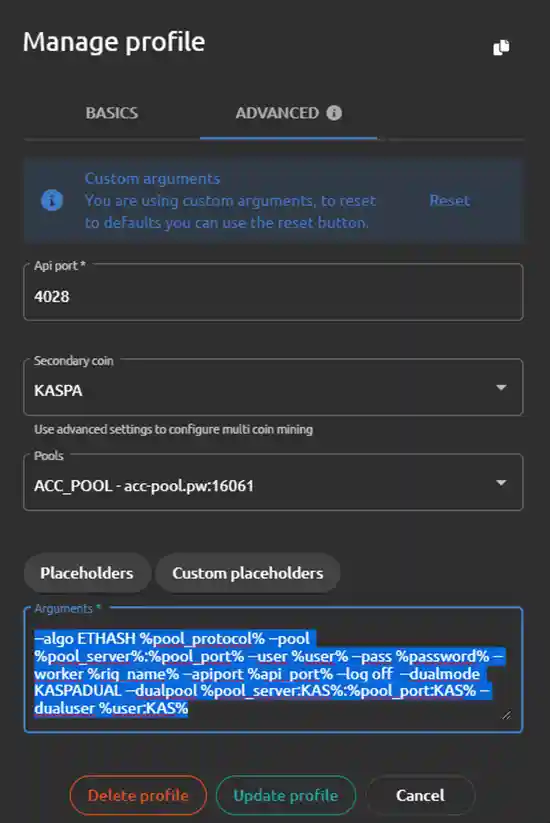Lol Miner 1.88: Setup, Commands & algorithms. Lhr unlock
This page describes how to get started mining with lolMiner 1.88 and newer.
Download for Windows / Linux
Download from the website Download releases from GitHub Download from BitcoinTalk
Review and DevFee
LolMiner - is a program for mining cryptocurrencies such as Kaspa, Beam, Ethereum Classic and many others. The software runs on Windows and Linux platforms.
DevFee (Ironfish) - 1%.
Setting up
lolMiner.exe --algo FISHHASH --pool de.ironfish.herominers.com:1145 --user ef0d75cb0974303fc1fc54a0bb113a0fe8bf91cc49204be9f267ae95a6b5222d.ss --dualmode TONDUAL --dualpool stratum+tcp://ton.hashrate.to:4002 --ton-mode 6 --dualuser EQBX63RAdgShn34EAFMV73Cut7Z15lUZd1hnVva68SEl7sxi --fan 90 pause
To set up a batch file, we need to enter three commands:
-
set "POOL=eu1-etc.ethermine.org:4444"- specify the pool address -
set "WALLET=0x360d6f9efea21c82d341504366fd1c2eeea8fa9d.lolMinerWorker"- specify the wallet address and farm name (any) -
lolMiner.exe --algo ETHASH --pool !POOL! --user !WALLET! timeout 10- we leave the standard command to run and the algorithm.
This is how the lolminer batch file for eth will look:
@echo off
setlocal enableDelayedExpansion
Rem #################################
Rem ## Begin of user-editable part ##
Rem #################################
set "POOL=eu1-etc.ethermine.org:4444"
set "WALLET=0x360d6f9efea21c82d341504366fd1c2eeea8fa9d.lolMinerWorker"
Rem #################################
Rem ## End of user-editable part ##
Rem #################################
lolMiner.exe --algo ETHASH --pool !POOL! --user !WALLET!
timeout 10
Video Guide
Batch file for Nicehash
lolMiner.exe --algo ETHASH --pool daggerhashimoto.eu-west.nicehash.com:3353 --user 3HHG3zpxP4AmbKDR9iRy1c2bqAb4WKhNwm.worker --tls 0 --ethstratum ETHV1
pause
This is the second, easier way to specify a batch file:
And an explanation:
-
lolMiner.exe- the name of the program that will be launched -
--algo ETHASH- algorithm name -
--pool daggerhashimoto.eu-west.nicehash.com:3353- specify the pool address and port -
--user 3HHG3zpxP4AmbKDR9iRy1c2bqAb4WKhNwm- specify the wallet address from Nicehash -
.worker- after the dot we indicate the name of the worker (any name) -
--tls 0- specify the TLS type (leave 0) -
--ethstratum ETHV1- specify the type of protocol Stratum
A finished example:
lolMiner.exe --algo ETHASH --pool daggerhashimoto.eu-west.nicehash.com:3353 --user 3HHG3zpxP4AmbKDR9iRy1c2bqAb4WKhNwm.worker --tls 0 --ethstratum ETHV1
GMiner & lolMiner LHR ETH Unlock?? (Low Power?) Tested with RTX 3060
GMiner and lolMiner have both released the latest versions of their respective miners, which boast a similar 65-69% unlock for ETH for the LHR cards when combared to NBMiner. However, they apparently now consume less power too! Ill test is out on Zotac Twin Edge OC RTX 3060 to see if that promise holds up!
a 70% ETH Hashrate Unlock for LHR (Limited Hash Rate) GPUs! Time to test it out on my LHR EVGA 3080 & LHR Zotac 3060 Ti! Does it actually deliver on its 70% FHR promise?
Lolminer - ETH unlock on RTX 3060 LHR v2, RTX 3070 LHR and RTX 3080 ti
Fantastic video. I'm mining ravencoin with my 8 3060ti on Hiveos. I want to get as many as possible before halving. I'm getting 27.5mhs with core 220, mem 800 and power 145w.
Automatic change from ETH to ETC for the Merge
To make an automatic transition to ETC when the ETH pool goes down after Ethereum Merge, you need to have lolMiner 1.88+.
It is as easy as add etc: like this in the Extra Config:
--pool etc:eu1-etc.ethermine.org:4444 --user 0x85Df244a3C8d6442225360bE681B7F7D803c0e78
HiveOS:
RaveOS:
That will continue Mining in this case KASPA and continue doing ETC.
It can be used to dual Mine KASPA or ALPH or simple ETC.
In case you want a SSL just add ssl:// before etc:
--pool ssl://etc:eu1-etc.ethermine.org:4444 --user 0x85Df244a3C8d6442225360bE681B7F7D803c0e78
Commands
To start mining with Lolmeiner, you need to specify three things, namely:
- Mining algorithm.
- Pool address or solo address to connect.
- Username / wallet for mining.
Configure the algorithm for mining
LolMiner has two ways to specify the algorithm you want to mine. You need to choose one of them to start mining.
The first option is --algo (-a) followed by one of the following algorithm names:
| Parameter | Algorithm |
|---|---|
| AUTOLYKOS2 | Autolykos |
| BEAM-I | BeamHash |
| BEAM-II | BeamHash |
| BEAM-III | BeamHash |
| C29AE | Cuckoo |
| C29D | CuckarooD |
| C29M | CuckarooM |
| C30CTX | Cuckaroo |
| C31 | Cuckatoo |
| C32 | Cuckatoo |
| CR29-32 | Cuckaroo |
| CR29-40 | Cuckaroo |
| EQUI144_5 | Equihash |
| EQUI192_7 | Equihash |
| EQUI210_9 | Equihash |
| ETCHASH | Etchash |
| ETHASH | Ethash |
| UBQHASH | Ubqhash |
| ZEL | ZelHash |
| KHeavyHash | KASPA |
Note that you can always find out the supported algorithms with the command: lolMiner –list-algos. The size of the commission will also be shown. This list will inform you if the program supports the algorithm / requires the personalization parameter (--pers), which is needed for some Equihash-based algorithms.
The second way to configure lolMiner is through the --coin (-c) parameter. This option sets more detailed settings for the selected profiles and allows you to use special features such as algorithm switches or a combination of an algorithm with the correct personalization.
You can check the detailed list of additional parameters for lolMiner using the lolMiner -h command.
Dual mining
Dual mining is the process of mining two specific coins on the same video card (or mining farm). Thanks to dual mining, you can increase your profit. You can mine ETH/ETC/UBQHASH and Kaspa at the same time.
You need to make sure that on Windows or Linux (HiveOs, RaveOS) you update the program to the latest version.
We must also take into account that the power supply may require a few extra watts. This is because during dual mining, the power consumption of video cards increases, the temperature increases accordingly, as well as the cost of electricity.
Here is what we get after setting up.
Just set up your batch file or flightsheet/profile/wallet ETH/ETC/UBQHASH and go to settings:
For HiveOS
Enter Setup Miner Config and write Extra config arguments.
Select KASPADUAL, then you must specify the address and port of the pool:
Pools
EU: acc-pool.pw:16061 or 162.55.7.43:16061
US: ca.acc-pool.pw:16061 or 144.217.11.196:16061
Rusia: ru.acc-pool.pw:16061 or 185.200.240.114:16061
Asia: hk.acc-pool.pw:16061 or 103.161.224.217:16061
Example:
--dualmode KASPADUAL --dualpool acc-pool.pw:16061 --dualuser kaspa:qrkqwe4kzpd8hv3l4fatgzyzj4l3yygrs2yqx4nvz08lsgzdpqc8zt302prna
3070s non lhr. Try:
- 1350 Core clock
- 2400 Mem clock
- Power Limit 150W
i get 60mhs on ETH. Some work at 145pl, some need 155w.
For RaveOS
Just select a pool and click on the pencil icon.
There we must add the command:
--dualmode KASPADUAL --dualpool acc-pool.pw:16061 --dualuser kaspa:qrkqwe4kzpd8hv3l4fatgzyzj4l3yygrs2yqx4nvz08lsgzdpqc8zt302prna
Command for RaveOS: --enablezilcache --dualmode zil --dualpool eu.ezil.me:5555 --dualuser %WAL%.your_zil_wallet
Please note that in dual mode, the hashrate on Ethereum may drop, and the cards will become very hot, and power consumption will increase.
Batch file:
set "POOL=eth.hiveon.com:4444"
set "WALLET=0x5576999cc34c1c0030f28939444d6ba9cd6919c2.lolMinerWorker"
set "ALEPHPOOL=fi.alephium.herominers.com:1199"
set "ALEPHWALLET=14xchBfD4bwxdti44NyjK5BQWympyHuxAREigL2UkZCgZ"
For MMPOS
Go to Miner Profiles, Manage Profile and Advanced and select your secondary coin. And in the arguments, specify:
Complete list of commands
Allowed options:
General:
-h [ --help ] Help screen
--config arg (=./lolMiner.cfg) Config file
--json arg (=./user_config.json) Config file in Json format
--profile arg Profile to load from Json file
--nocolor [=arg(=on)] (=off) Disable colors in output
--basecolor [=arg(=on)] (=off) Use 16 colors scheme for non-rgb terminals
--list-coins List all supported coin profiles
--list-algos List all supported algorithms
--list-devices List all supported & detected GPUs in your system
-v [ --version ] Print lolMiner version number
Mining:
-c [ --coin ] arg The coin to mine
-a [ --algo ] arg The algorithm to mine. This is an alternative to --coin.
-p [ --pool ] arg Mining pool to mine on. Format: <pool>:<port>
-u [ --user ] arg Wallet or pool user account to mine on
--pass arg Pool user account password (Optional)
--tls arg Toggle TLS ("on" / "off")
--devices arg The devices to mine on
Values: ALL / AMD / NVIDIA or a comma separated list of indexces.
--devicesbypcie [=arg(=on)] (=off) Interpret --devices as list of PCIE BUS:SLOT pair
--pers arg The personalization string.
Required when using --algo for Equihash algorithms
--keepfree arg (=8) Set the number of MBytes of GPU memory that should be left free by the miner.
--benchmark arg The algorithm to benchmark
Managing Options:
--watchdog arg (=script) Specify which action to take when a card is detected to be crashed.
"off": Continue working on remaining cards. No action.
"exit": Exit the miner with exit code 42 to ask for a restart. Recommended
for Nvidia cards.
"script": Call an external script.
Default and recommended for AMD cards.
--watchdogscript arg Specify which script to be executed when a hung GPU is detected
--computemode [=arg(=1)] (=0) Ask lolMiner to enable AMD compute mode for supported GPUs. Requires previleges to change system settings.
--singlethread [=arg(=-1)] (=-2) Enable single mining thread mode for all GPUs (-1) or for a specific GPU id.
--tstart arg (=0) Minimal temperature for a GPU to start in degree C. If set to 0 disables restart below a fixed temperature.
--tstop arg (=0) Temperature to pause or stop a GPU from mining in degree C. If set to 0 disables stop above a fixed temperature.
--tmode arg (=edge) Mode for temperature management. Use "edge" (default), "junction" or "memory" to set the mode for temperature management.
Statistics:
--apiport arg (=0) The port the API will use
--apihost arg (=0.0.0.0) The host binding the API will use
--longstats arg (=150) Long statistics interval
--shortstats arg (=30) Short statistics interval
--statsformat arg (=default) Format for long statistics.
Use --help-format to get an overview of
available fields.
--help-format [=arg(=1)] Format description for --statsformat
--digits arg Number of digits in hash speed after
delimiter
--timeprint [=arg(=on)] (=off) Enables time stamp on short statistics
("on" / "off")
--compactaccept [=arg(=on)] (=off) Enables compact accept notification
--log [=arg(=on)] Enables printing a log file ("on" /
"off")
--logfile arg Path to a custom log file location
Overclock (Experimental):
--cclk arg (=*) The core clock used for the GPUs. Cards
are separated with a comma. "*" can be
used to skip a card.
Ethash Options:
--ethstratum arg (=ETHPROXY) Ethash stratum mode. Available options:
ETHV1: EthereumStratum/1.0.0 (Nicehash)
ETHPROXY: Ethereum Proxy
--worker arg (=eth1.0) Separate worker name for Ethereum Proxy
stratum mode.
--mode arg (=b) Kernel mode to mine on. Comma separated
values for configuring multiple cards
differently.
--lhrtune arg (=0) Offset to most important LHR
parameters. If your card is unstable or
does not unlock try negative values.
Range is +/-20.
--disable-dag-verify [=arg(=1)] (=0) Disable the CPU side verification and
repair of DAG.
--4g-alloc-size arg (=0) Sets the DAG size (in MByte) the miner
is allowed to use on 4G cards. Can be a
comma separated list of values for each
card. Suggested values:
Linux: 4080 Windows: 4024
--zombie-tune arg (=auto) Sets the Zomie tune mode (auto or 0-3)
for Polaris GPUs. Can be a comma
separated list of values to set for
each card individually.
--dagdelay [=arg(=0)] (=-1) Delay between creating the DAG buffers
for the GPUs. Negative values enable
parallel generation (default).
--enablezilcache [=arg(=1)] (=0) Allows 8G+ GPUs to store the DAG for
mining Zilliqa. It will generated only
once and offers a faster switching.
--benchepoch arg (=350) The DAG epoch the denchmark mode will
use
Ethash Expert Options:
--workmulti arg (=180) Modifys the amount of Ethash work a GPU
does per batch.
--rebuild-defect arg (=3) Triggers a DAG rebuild if a card
produced <param> defect shares. Default
is 3, use 0 to deactivate the rebuild.
--enable-ecip1099 [=arg(=on)] (=off) Enable reduced DAG size for mining ETC
from block 11.880.000 and higher.
--disableLinux56fix [=arg(=on)] (=off)
Disables the startup workaround for
Polaris GPUs on Linux kernel 5.6.
--win4galloc [=arg(=1)] (=1) Enables (1) / Disables (0) experimental
4G DAG allocation mode on Windows.
Algorithm Split Options:
--dualmode arg (=none) Dual mode used. Allowed options: none, zil, zilEx, eth, etc
--dualpool arg Pool configuration for extra connection, Format <pool>:<port>
--dualuser arg Username or wallet address for the extra connection
--dualpass arg Password for the extra connection (Optional)
--dualdevices arg Split rule for etc and beam split mode.
Use a comma separated list of indexes or "4G" (default).
Algorithms and DevFee
| Algorithm | Fee % |
|---|---|
| Alephium | 0.75 |
| Autolykos V2 | 1.5 |
| BeamHash III | 1.0 |
| Cuckoo 29 | 2.0 |
| CuckarooD 29 | 2.0 |
| CuckarooM 29 | 2.0 |
| Cuckaroo 30 CTXC | 2.5 |
| Cuckatoo 31 | 2.0 |
| Cuckatoo 32 | 2.0 |
| Cuckaroo 29-32 | 1.0 |
| Cuckaroo 29-40 | 1.0 |
| Dual ETC + (KAS/ALEPH) | 1.0 / 0.0 |
| Dual ETH (ETHW) + (KAS/ALEPH) | 1.0 / 0.0 |
| Equihash 144/5 | 1.0 |
| Equihash 192/7 | 1.0 |
| Equihash 210/9 | 1.0 |
| Etchash | 0.7 |
| Ethash (ETHW) | 0.7 |
| Kaspa | 0.75 |
| Nexa | 2.0 |
| ZelHash (Flux) | 1.0 / 1.5 |
Driver requirements
Nvidia: Cuda 10 or 11
AMD:
- Big Navi: amdgpu-pro 20.40 (Linux) / Adrenaline 20.11.2 (Windows) and newer.
- Navi: amdgpu-pro 19.30 (Linux) / Adrenaline 19.10.02 (Windows) and newer.
- Vega: amdgpu-pro 18.50 (Linux) / Adrenaline 18.10 (Windows) and newer.
- old cards: Blockchain drivers and newer.
Alternatives
CPU mining:
Flash bios program:
Errors
Unrecoverable memory error by gpu
This error usually occurs when the miner is overclocked too much. Try lowering the frequency of your video card’s memory. For example, on a 3060ti, reduce the memory overclock to 1500. And on a 3060TI, the overclock can be around 1750.
Releases and updates
- Improved Kaspa performance in ETC and ETHW dual mining by about 6-7% on AMD (Big) Navi GPUs and 10-12% on Nvidia Turing and Ampere, measured at the same Ethash speed. The actual improvement depends on the concretely selected dual factor. Re-tuning your setup is highly recommended.
- Improved Kaspa performance in Kaspa only mining mode by 0.6 to 1.2% on Nvidia GPUs and 0.4-0.5% on AMD (Big) Navi GPUs at approximately same power draw.
- Beta feature: Added experimental support for AMD RX7900 series. Supported algorithms: Et(c)hash, kHeavyHash and the corresponding dual mining.
Fixes
- Fixed some minor display bugs.
- Major performance increase for Flux mining on Nvidia Ampere GPUs
- Major performance increase for Beam mining on Nvidia Ampere GPUs
- Mining Flux and Beam on all Nvidia GPUs now uses Cuda instead of OpenCL
- Slight performance improvements for Flux mining on AMD RX 500, RX 5000 and RX 6000 (about 0.2 it/s)
- Mining any Equihash based coin (Flux, BTG, Aion, …) now supports extra nonce subscription via stratum (e.g. for better profit switching pool experience)
- Added option
--no-clto disable detection of OpenCL powered GPUs (fixes a crash on some rigs where the Nvidia OpenCL driver crashes - happens mostly when having a rig with many GPUs)
Fixes:
- Disabled DAG checking for ETC mining on 4G AMD GPUs, because this was always failing (investigating to bring it back asap)
- Nvidia LHR cards will no longer run the LHR unlock when not mining Et(c)hash or Ergo - this will prevent them from crashing on some other algorithms.
- extensively stepped forward Flux mining performance on AMD RX 5000 (+10% on 5700) and AMD RX 6000 based totally GPUs (+15-22%)
- Mining Flux, Beam, Equihash a hundred and forty four/5 and Equihash 192/7 will now show the new iteration/s (it / s) for simpler OC tuning and the pool sol/s calculated from submitted and regular shares.
- Flux mining can now be decided on via
--algo FLUXwithout needing to specify--pers. - enabling Equihash one hundred forty four/5 and Equihash 192/7 will now also help
--persas opposed to capital--pers autofor enabling pool automated selection. - added DAG take a look at and restore characteristic for Ethereum classic mining as much as epoch three hundred.
- delivered ETH / and so on + Kaspa code for Nvidia Pascal based totally GPUs.
- delivered choice to blend extraordinary Ethash style algorithms when using the fail-over pool function. to use this you presently can use
eth:,etc:andubiq:as a prefix on your fail-over pool address to indicate this pool uses a specific set of rules then the one configured first of all. this may permit to mechanically switch from Ethash to an Etchash pool while “the merge” happens as you could configure for regular Ethash mining and configure one of the fail-over pools as Etchash, so when the primary pool receives disconnected or rejects the authorization (these two are anticipated behavior for Eth swimming pools after the merge), then the miner can transfer to a fail-over e.g. configured to mine Etchash. See instance filesmine_eth_backup_etc.shormine_eth_backup_etc.baton a way to use it.
Note: when using this feature with prefixes like tls:// or ssl://, then put the new prefix after the prefix for the communication layer. So tls://etc: is valid, while etc:tls:// is not.
Fixes:
- Fixed a bug that might cause the digger to crash when an Ergo pool association ought to reconnect. Fixed a bug that can cause arbitrary invalid shared when mining Kaspa on AMD GPUs.
- Settled a bug that can cause arbitrary invalid shares when mining Kaspa on AMD GPUs
- Fixed a bug sometimes causing duplicate send shares in Kaspa dual mining.
- Fixed a bug “Received a defect stratum message: conversion of data to type “b” failed” on new Kaspa pools and the solo mining adapters.
- Fixed a bug causing
--dualworkernot to work right with Kaspa dual mining.
- Improved performance of Nvidia LHR V2 cards in Ethash to 79 - 79.5% (86.5 - 87 % on RTX 3060 V1 and 460.39 driver). Note that dual mode codes remain unchanged.
- Added an experimental zombie mode for Nvidia Pascal generation 5GB cards, allowing them to continue mining Ethash after epoch 492 (in Linux).
- Reduced fee for LHR unlocker back to 0.7%. Now all Ethash solo codes have only 0.7% fee (again).
- LHR cards that have memory junction temperature sensors will automatically throttle LHR unlock by ~0.4 - 0.5% when hitting 106° C memory clock to prevent unneeded locks.
- LHR calibration on startup now taking approx 2 minutes instead of 4.
- Extended crc table for Ethash up until epoch 550.
- Changed default behavior for
"."signs in wallet address when Ton or Aleph dual mining. These will now automatically separate the string at the given position, so the thing after a . is treated as worker name. -Fixed a bug that may cause TLS connections not cleanly reconnecting after a connection loss.
- Slightly improved initial speed after startup on 510.x & 512.x drivers allowing to reach best performance faster
- Made the LHR unlocker more robust against small changes in work load. We still recommend to not put other load then mining during the calibration phase - after that is finished, the miner is more robust.
- Full hash rate cards will disable LHR detection latest one minute after
--lhrwaithas passed. This means that by default one minute after the DAG was created the cards now get “protected” from further detection. - Added Nvidia core junction temperature reading
- Change in configuration for making it more comfy: If the number of entries for
--cclk,--mclk,--lhrtuneor--maxdualimpactmatches exactly the number of selected GPUs, the miner will now automatically skip over the inactive devices. E.g.--devices 1,2,4 --cclk 1050,1400,1500now makes sense, while before--cclk ,1050,1400,,1500was needed to skip over inactive devices.--lhrtune 0is now semantically identical to--lhrtune off - Changed handling of user/wallet names containing one or multiple dots. This should fix issues with mining rig rentals and ezil pool. Note: some pool might not like appending your user name with a dot. If so and you get authorization rejected make sure you use
--workerinstead - Fixed a bug causing LHR unlock not working when too many GPUs needed to perform DAG repair in Aleph dual mining (yea, that is a special case one … )
- Fixed a bug causing RTX 3050 & RTX 3080 12GB to have extremely low Ethash performance when dual mining
- Fixed a bug causing dual mining hash rate on FHR cards not showing up during dual mine calibration in 1.47
- Fixed a bug causing
--lhrtune offoccasionally not to work in 1.47.
- Added experimental Ethash + Ton dual mining kernels for Nvidia Pascal generation GPUs.
- Setting the parameter
--maxdualimpactto 0 will now completely disable dual mining on this card. - Setting the parameter
--dualdevicescan now be used to make GPUs mine Ton only in Eth+Ton dual mode. In combination with--maxdualimpactthis means one can choose for every card which algorithm to mine. - Automatic tuning for dual mining will now always make sure the parameter is adjusted so the GPUs start on both algorithms if
--maxdualimpactis not set. Manually setting--maxdualimpactwill disable automatic parameter stretching. - icemining.ca Ton stratum now can use the
--passor--dualpassparameter to apply pool settings. - Fixed a bug that might cause a
SIGSEVorSIGPIPEcrash on some Linux platforms when reconnecting. - Fixed a bug with
icemining.caTon stratumnot sending correct job id when dual mining on AMD cards.
Added ability to lock the memory clock on Nvidia RTX 3000 series. Use parameter --mclk to do so (requires admin / sudo permissions and Nvidia driver 470 series or newer).
- Improved performance of Nvidia TON kernels, especially significant on Turing based GPUs.
- improved performance of TON solvers by up to 1.5% depending on your GPU;
- lowered TON miner fee to 1.5% –> 1%;
- increased
TON httpsmining polling interval for less server load; - improved blocking preventing mechanisms lolMiner can now communicate with
stratumsusingwebsocketsstarting withwss://; - significantly improved TON mining pool compatibility;
- added a new parameter
--ton-modeto toggle between modes;
Bug fixes: fixed a bug with TON https polling causing random crashes on some machines; fixed a bug with TON: defect shares were not displayed in stats overview; fixed a bug with TON OpenCL back end: miner did trigger watchdog when a GPU was halted and waiting for work)
Feature Changes
- Added support for mining TON. Use
--algo TONto mine it. Developer fee is 1.5%, AMD cards since GCN1 (via OpenCL) and Nvidia cards Maxwell and newer generation (via Cuda) are supported. - Added support for mining Ubiq. Use
--algo UBQHASHto mine it. The fee is 0.7% as with all Ethash based coins. - Added support for routing your stratum traffic through a socks5 proxy server. Use
--socks5: to enable it. Note: at the moment this does not work with https traffic as in the TON algorithm. We will work on that.
Fixes
- Added a timeout for DOH requests, so they can no longer hang indefinitely.
- Fixed ethash support for RX 5500 series GPUs on more recent drivers.
Notes about TON pool connection:
At the moment only the https pool communication protocol is supported. Therefore your --pool address must start with https://. This protocol is not ideal for mining, but we work on establishing a real stratum protocol with some pools in the near future, stay tuned!
Note when using a pool address starting with https:// specifying a port is optional (the default 443 is used when not specifying one). Also when mining TON via https lolMiner automatically uses TLS 1.2 encryption with skipped host name verification. As a final notice: always make sure your TON pool either does not need miner wallet registration or you registered - many popular pools require to register your wallet address to mine it.
Notes about TON performance and tuning:
With regard to tuning for TON: The algorithm needs core, core and more core. Therefore maximizing the core clock within the limits of you cooling and energy supply is the key for the ideal performance. It might be beneficial to reduce the core voltage to produce less heat and less energy consumption - this way the cards keep more distance to their thermal limits and can often clock higher as well. We recommend this algorithm on your AMD RX 6000 cards!
- Added DNS over HTTPS name resolving for establishing your pool connection. This has advantages when your normal DNS resolving might be blocked or modified by a firewall. You can control its behavior with the parameter
--dns-over-httpsvalue with the values 0: turns DNS over HTTPS off; 1: DNS over HTTPS is enabled, fallback to normal DNS resolving is possible (default); 2: enforcing DNS over HTTPS, normal DNS is completely disables (1) - Updated internal libraries for TLS connection handling
- Moved more fee pools to use TLS connection. When mining Ethash, Etchash (both +ZIL), Ergo and Beam the fee connection is now always encrypted (TLS 1.2) and mining data packages can not be identified as such.
- Changed LHR kernel defaults for RTX 3060 and RTX 3070, because the default ones had an issue with defect shares at high oc.
(Note: The windows version will be delayed a bit - we need to make sure first LHR unlocking is working there as expected) Feature Changes
- Improved Ethash performance on Turing based graphic cards (GTX 16 series, RTX 20 series, lower tier CMP cards) by about 0.4 to 0.7%.
- Improvement of Ethash performance (up to 1%) and reduction of stale share rate for Maxwell and Pascal (GTX 10) based GPUs.
- Changes LHR tuning algorithm to minimize the number of locks & time for finding a stable value: The tuning might be improved by the miner later once stable for long enough time.
- Improved LHR performance for 3060 V1 (GA106-300-A1) on older drivers (460.39 and earlier)
- Added Ergo kernels for RX 6700XT and RX 6600 (XT) on newer AMD drivers.
- Ethereum stratum code will now print the pool difficulty in better human readable number
- The miner will now print the ip of the connected pool - to be able to detect e.g. faulty DNS entries
- Added parameters
--dualtlsand--dualworkerto toggle TLS and the worker name for the dual connection. To be used as with the parameters for the standard connection. -
--statsformatcan now distinguish between the number of LHR locks “lhrlks” and the current--lhrtuneparameterlhrparam - Added a parameter
--vstatsto modify the terminal width in number of characters to overwrite the automatic detection, which sometimes does not work with some terminal emulators like putty. - Added a parameter
--hstats. Given this parameter will switch the statistics to a way such that the statistics write a horizontal line per GPU instead of the default vertical (see screenshot below). When the automatic read terminal width is reached, the remaining entries will be printed to a 2nd set of lines. The vertical statistics can be combined with the usual--statsformatpatterns to customize the displayed values per card. The optional number overwrites the the automatic screen width detection. To fit all values of--statsformatextended into one line we need--hstats 150or higher (recommended setting this value manually when accessing the rig via terminal emulator). Fixes - Fixed 3060 V1 (GA106-300-A1) internal parameters for drivers 460.39 and below, stabilizing the hash rate (they pretty much did not work stably unlocked in 1.36)
- Fixed a bug causing a wavy hash-rate report in some FHR rigs
- Fixed a bug causing
--modea kernels to be defect for Ampere and Turing GPUs in 1.36(a) releases - Fixed a bug causing a segmentation fault when trying to mine EXCC.
Feature updates
- Improved Ethash & Etchash performance on all Nvidia Turing & Ampere GPUs by 0.3 to 0.7% depending on card & system.
- Decreased rate of stales on Nvidia Turing & Ampere GPUs.
- Modified LHR auto tuning to use finer steps (0.2 instead of 1). Also when the miner is more then 2 hours stable on its current settings and a lock appears, the card will unlock again, but the tuning will not be reduced.
- New parameter:
--lhrwait nwill set the miner to wait n seconds, until the LHR detection and calibration gets active. Allows to wait for systems with delayed memory overclock settings.
Fixes
- Fixed a potential crash between switching between cached Eth and Zil dag on Nvidia cards
- Fixed a bug: Worker name got lost on ezil.me mining pool (since 1.34)
- Fixed a bug causing rare defect shares on LHR cards
- 1.36a: Fixed a bug causing no LHR unlock to normal speed after epoch change
- 1.36a: Reverted some LHR kernels to a specification more similar to what was in 1.35. These are default in Windows and on RTX 3080 on Linux, other cards can request this kernels by using
--lhrtune wautoor wTuneNumber in case the default is unstable.
Feature changes
- Ergo: Adjusted all codes mining Autolykos v2 to be ready for the epoch 1 and higher, starting Sunday Nov 7th ~8 am UTC. To continue mining Ergo, please update to this version. (1)
- Ergo: Added ability for all AMD cards to pre-build the next Ergo data set while mining. This is at a cost of slightly slower mining directly after a height change, but generally improves poolside performance. In case you find it unstable the pre-building can be deactivated by using parameter
--ergo-prebuild -1 / 0 / 1. Here -1 stands for the cards default, 0 is off, 1 is on. Default is on for all AMD GPUs except GCN1 and Vega generations - those were more stable with the option turned off. The value can be set per card by using a comma separated list of values. -
Ergo: Improved performance of AMD Hawaii generation of chips by about 2%. -
Ethash: Added error correcting tables to check the DAG integrity up to epoch 499 (Early June 2022) -
Ethash: Added option to use the version 1.33 semi-unlocker style - this was more performant for some GDDR6X cards. Use--lhrtune xautoto activate the 1.33 solver style auto tuning and use –lhrtune x to set a predetermined tune value. The 1.33 style solver can be mixed with 1.34+ style solvers by using a comma separated list of values.
Bug fixes
- Ethash: Fixed a bug some crashed Nvidia cards did not trigger the watchdog
- Ethash: Fixed a bug causing the worker name not to be correctly passed to the pool in some cases in 1.34(a)
(1) The new Ergo epochs will increase the size of the data set used for mining by 5% every ~75 days. Some cards might need a bit more core clock to achieve the used performance. Also 2G cards in zombie mode will see a significant reduction in speed, because the data set is more then 2150 MBytes in size now.
- Added further epochs to the dag correction detection / table. This can resolve issues with defect shares that appeared in 1.34 or earlier with start of epoch 450.
- Slightly changes internal LHR parameters of 3070 ti & 3080 - we hope to improve stability by this plus a small speedup.
- Improved performance of RTX 3060 and RTX 3060 Ti by up to 2%, generally allowing a bit less core clock.
- Auto tuning will now be quicker to reasonable hashrates.
- Improved stability on found parameters.
- Found parameters that are hard coded with
--lhrtuneare now applied within 30 seconds after dag build. -
--lhrtunenow understands the parameter “off” to disable any kind of LHR handling - this is useful for cards that sometimes trigger the lhr detection although they are non-LHR. - Improved compatibility with many current drivers. Still on Linux we recommend 470.74 for LHR v2 cards. The 460 series drivers might perform up to 0.5% worse. For 3060 LHR V1 use either 460.39 or earlier driver.
- The parameter
--workmultinow has effect on Nvidia GPUs on Ethash. Default value is 192, lower values will improve stale count, higher values will reduce CPU load (and can be a tiny bit quicker, although only very tiny). - Added support of RTX A6000 / RTX A5000 / RTX A4000 (and future RTX A2000) Nvidia workstation GPUs.
- Reduced RAM usage of Nvidia Ethash solver (some 10+ card rigs got issues with 1.33 when they only had 4G of memory).
-
--statsformatnow understands the string “lhrinfo” to print the--lhrtuneparameter and the lock count in custom set up statistics. - Fixed a bug with
--tstopor a lost stratum connection triggering a LHR GPU to lock. - Fixed a bug that RTX 3070Ti only triggered the lock detector on rather low memory clock.
- Fixed a bug with invalid shares in Pitcairn Ergo Zombie mode.
- Improved stability of Ethash stratum and statistics module.
1.33
Core Feature: Complete rework of LHR semi-unlock feature.
- Better performance of LHR semi-unlock, about 70%+ on GDDR6x cards (3070 Ti & 3080 (Ti) ), about 71-72%+ on GDDR6 (3060 (Ti) & 3070), 81%+ on 3060 LHR V1 with the right drivers (earlier then 460.39). Recommended driver for LHR v2: 470.74 (Linux), 472.12 (Windows)
Important hint: We saw some calibration bugs with 460.93 driver (Linux). Please do not use it!
- Less performance difference between low and high core clock then earlier versions
- Cards are automatically detected if they are LHR - no more
--modeswitch required - In the beginning the miner will calibrate to your exact core & memory clocks. The total process takes 3-4 minutes total, one with rather low speed and the remaining time with speed closer to the final value. Try not to change any overclock after or during calibration, else the performance might be lower then expected!
-
--lhrtunehas now default value of auto for an automatic tuning. Results of automatic tuning will be displayed in stats after calibration is completed. Note: re-tuning of values used in 1.32a is required!
Other feature changes
- Default
--shortstatsinterval lowered to 15 seconds, default--longstatsinterval lowered to 60 seconds - More stable displayed hashrate on Nvidia cards when mining Eth
- Changes in Api: On supported algorithms the miner now exposes the number of stale shares in API (stales and defect shares are no longer collapsed into one value)
Fixes:
- Fixed a bug with processing old style
--dualmodeetc dualmine settings - Fixed some minor bugs of the API
- Fixed a bug causing a non-realistic high hash rate to be displayed on LHR cards when overclocked after start
